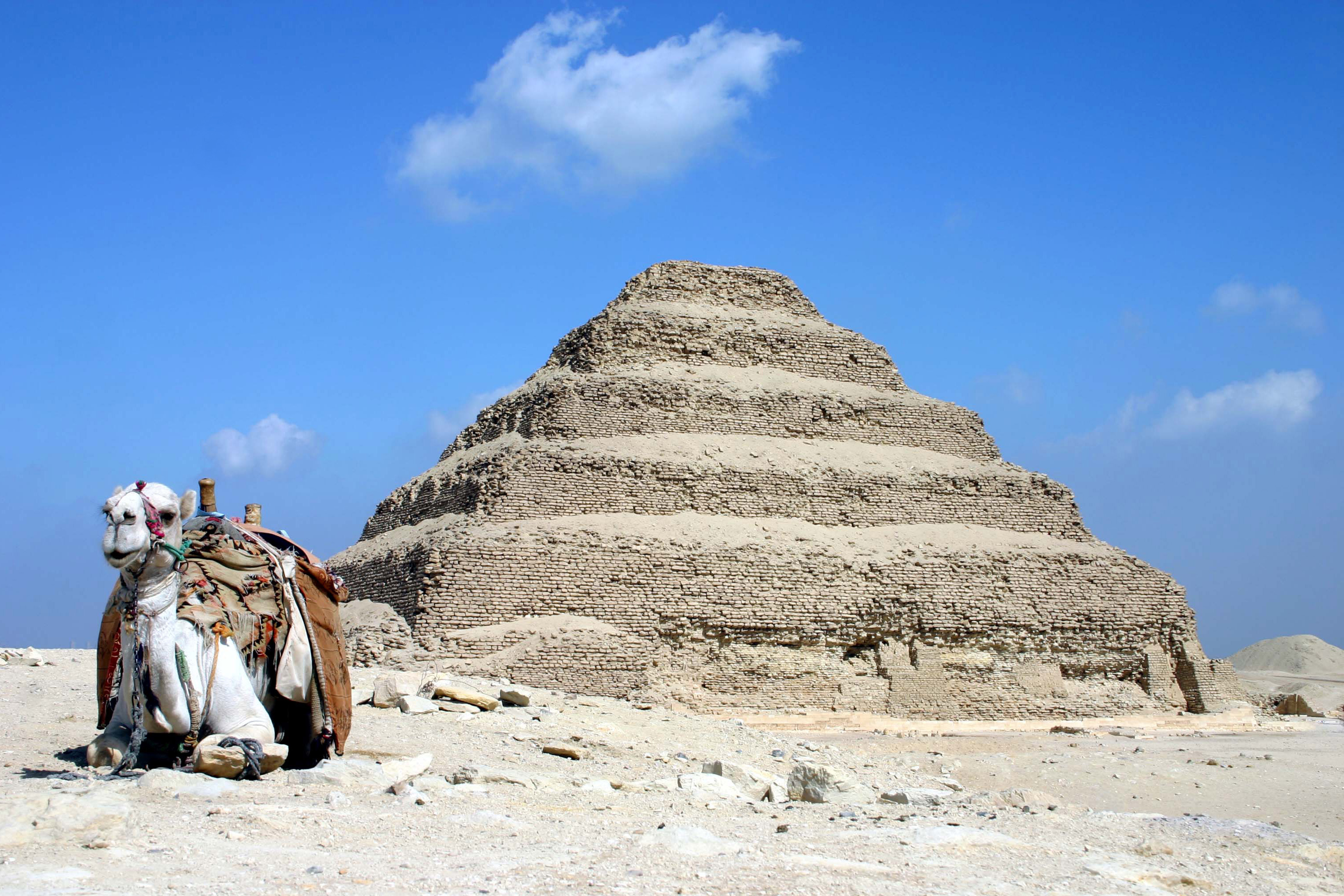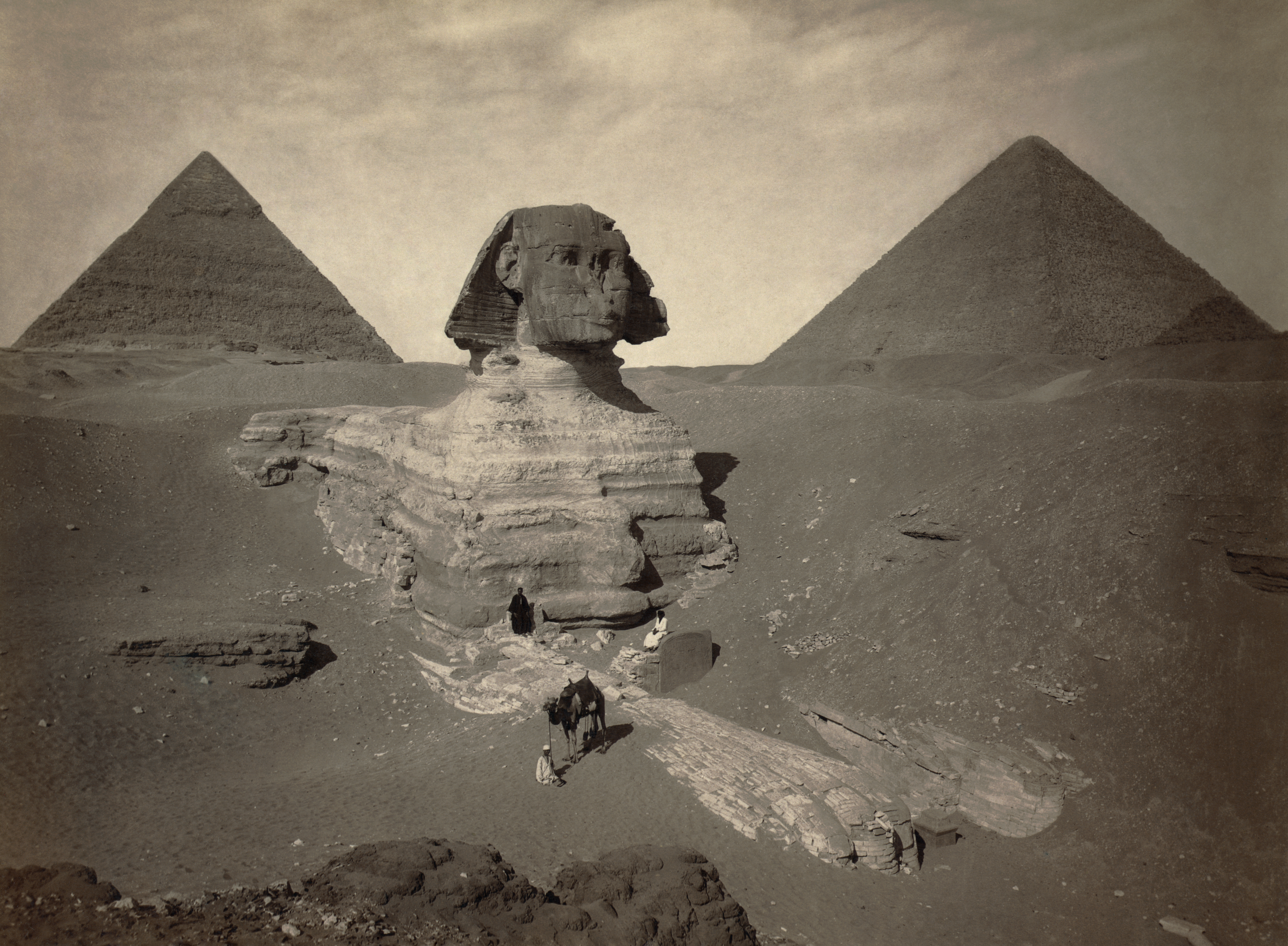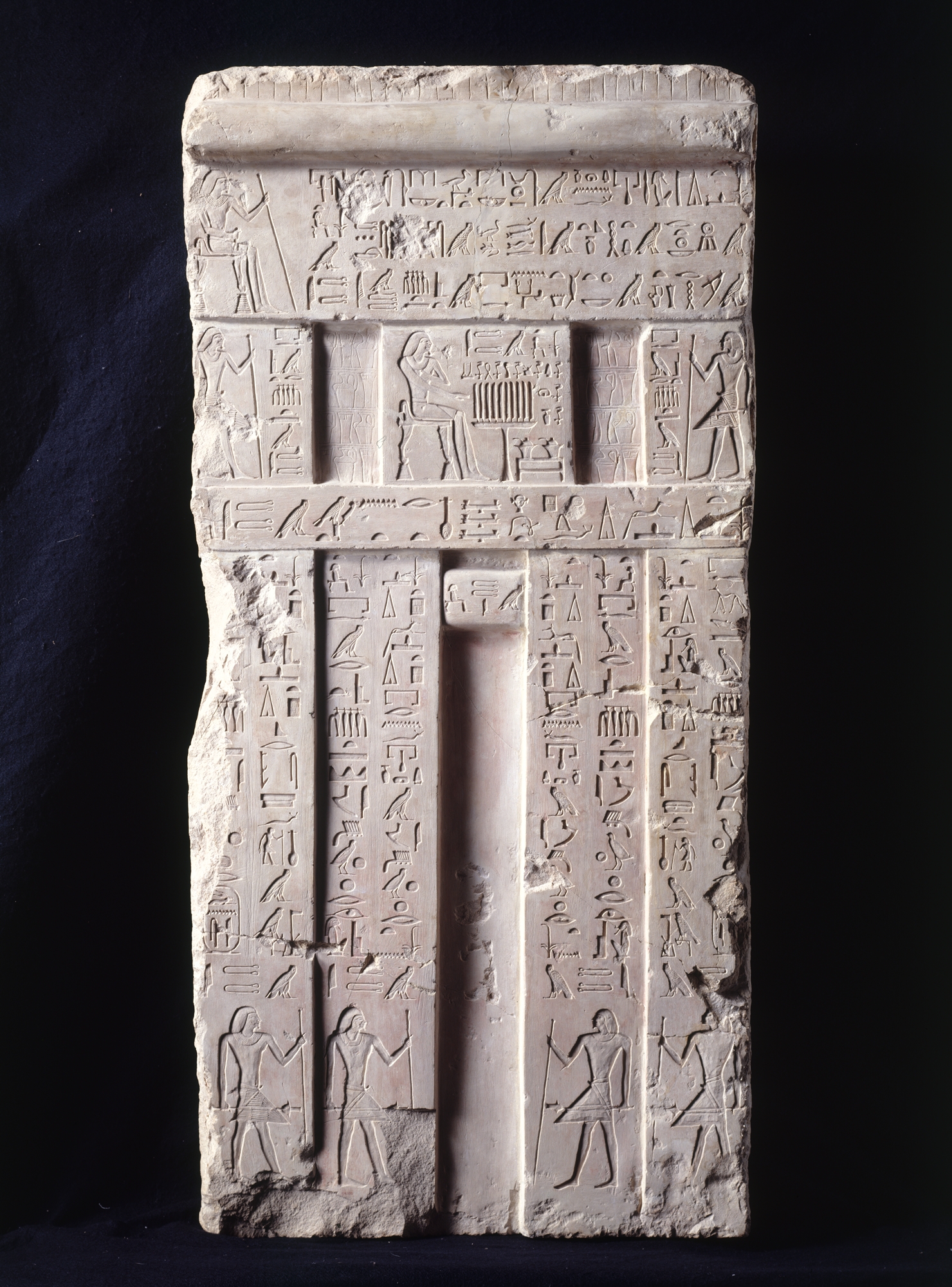|
Pyramid Of Djoser
The pyramid of Djoser, sometimes called the Step Pyramid of Djoser or Step Pyramid of Horus Netjerikhet, is an archaeological site in the Saqqara necropolis, Egypt, northwest of the ruins of Memphis.Bard, Kathryn A., and Jean-Philipee Lauer, eds. 1999. "Saqqara, pyramids of the 3rd Dynasty" ''Encyclopedia of the Archaeology of Ancient Egypt''. London: Routledge. 859 It is the first Egyptian pyramid to be built. The 6-tier, 4-sided structure is the earliest colossal stone building in Egypt. It was built in the 27th century BC during the Third Dynasty for the burial of Pharaoh Djoser. The pyramid is the central feature of a vast mortuary complex in an enormous courtyard surrounded by ceremonial structures and decoration. The pyramid went through several revisions and redevelopments of the original plan. The pyramid originally stood tall, with a base of and was clad in polished white limestone. As of 1997 the step pyramid (or proto-pyramid) was considered to be the earliest ... [...More Info...] [...Related Items...] OR: [Wikipedia] [Google] [Baidu] |
Saqqara Pyramid Ver 2
Saqqara ( : saqqāra ), also spelled Sakkara or Saccara in English , is an Egyptian village in the markaz (county) of Badrashin in the Giza Governorate, that contains ancient burial grounds of Egyptian royalty, serving as the necropolis for the ancient Egyptian capital, Memphis. Saqqara contains numerous pyramids, including the Pyramid of Djoser, sometimes referred to as the Step Pyramid, and a number of mastaba tombs. Located some south of modern-day Cairo, Saqqara covers an area of around . Saqqara contains the oldest complete stone building complex known in history, the Pyramid of Djoser, built during the Third Dynasty. Another sixteen Egyptian kings built pyramids at Saqqara, which are now in various states of preservation. High officials added private funeral monuments to this necropolis during the entire Pharaonic period. It remained an important complex for non-royal burials and cult ceremonies for more than 3,000 years, well into Ptolemaic and Roman times. Nor ... [...More Info...] [...Related Items...] OR: [Wikipedia] [Google] [Baidu] |
Gisr El-Mudir
Gisr el-Mudir (Arabic:جسر المدير, "bridge of the chief"), also known as the Great Enclosure, is one of the oldest known stone structures in Egypt, located at Saqqara only a few hundred metres west of the Step Pyramid and the Buried Pyramid. The function of the space is not yet clear. Description The structure consists of a rectangular wall oriented north-south and measuring about 650 by 350 metres. The walls consist of two outer walls made of roughly hewn limestone about 15 metres apart; the space between them is filled with crushed stone, gravel and sand. In the northwestern corner, the walls survive to a height of 4.5 to 5 metres (over 15 courses of stone). The style of construction suggests an original height of around 10 metres. In the south the state of preservation is clearly worse than in the north. Since the west wall of the structure is 30 metres shorter than the east, the south wall probably consisted of two parallel walls forming an entranceway. This pattern ... [...More Info...] [...Related Items...] OR: [Wikipedia] [Google] [Baidu] |
Walter Bryan Emery
Walter Bryan Emery, CBE, (2 July 1903 – 11 March 1971) was a British Egyptologist. His career was devoted to the excavation of archaeological sites along the Nile Valley.Archaic Egypt (bio), Walter B. Emery, Pelican Books, London, 1963. During the Second World War, he served with distinction as an officer in the British Army and, in the immediate aftermath, in the Diplomatic Service, both still in Egypt. Early life Walter Bryan Emery was born in New Brighton, Cheshire, the son of Walter Thomas Emery - the head of a technical college - and Beatrice Mary Emery. Emery was educated at St Francis Xavier's College, Liverpool. On leaving school, he was briefly apprenticed to a firm of marine engineering, marine engineers. His training there resulted in his becoming an excellent draftsman, a skill which produced the brilliantly executed line drawings that permeated his later published works on Egyptology, and which was similarly influential in his wartime military career. Field archa ... [...More Info...] [...Related Items...] OR: [Wikipedia] [Google] [Baidu] |
Anedjib
Anedjib, more correctly Adjib and also known as Hor-Anedjib, Hor-Adjib and Enezib, is the Horus name of an early Egyptian king who ruled during the 1st Dynasty. The Egyptian historian Manetho named him "Miebîdós" and credited him with a reign of 26 years, William Gillan Waddell: ''Manetho (The Loeb Classical Library, Volume 350)''. Harvard University Press, Cambridge (Mass.) 2004 (Reprint), , page 33–37. whilst the Royal Canon of Turin credited him with an implausible reign of 74 years.Alan H. Gardiner: ''The Royal Canon of Turin''. Griffith Institute of Oxford, Oxford (UK) 1997, ; page 15 & Table I. Egyptologists and historians now consider both records to be exaggerations and generally credit Adjib with a reign of 8–10 years.Wolfgang Helck: ''Untersuchungen zur Thinitenzeit''. (Ägyptologische Abhandlungen, Volume 45), Harrassowitz, Wiesbaden 1987, , page 124, 160 - 162 & 212 - 214. Name sources Adjib is well attested in archaeological records. His name appears in insc ... [...More Info...] [...Related Items...] OR: [Wikipedia] [Google] [Baidu] |
Mastaba
A mastaba ( , or ), also mastabah or mastabat) is a type of ancient Egyptian tomb in the form of a flat-roofed, rectangular structure with inward sloping sides, constructed out of mudbricks or limestone. These edifices marked the burial sites of many eminent Egyptians during Egypt's Early Dynastic Period and Old Kingdom. Non-royal use of mastabas continued for over a thousand years. The word ''mastaba'' comes from the Arabic word (maṣṭaba) "stone bench". The Ancient Egyptian name was pr- Djt, meaning "house of stability", " house of eternity", or "eternal house". History The afterlife was centralized in the religion of ancient Egyptians. Their architecture reflects this, most prominently by the enormous amounts of time and labor involved in building tombs. Ancient Egyptians believed that the needs from the world of the living would be continued in the afterlife; it was therefore necessary to build tombs that would fulfill them, and be sturdy enough to last for an eter ... [...More Info...] [...Related Items...] OR: [Wikipedia] [Google] [Baidu] |
John Romer (Egyptologist)
John Lewis Romer (born 30 September 1941, in Surrey, England) is a British Egyptologist, historian and archaeologist. He has created and appeared in many TV archaeology series, including ''Romer's Egypt'', ''Ancient Lives'', ''Testament'', ''The Seven Wonders of the World'', ''Byzantium: The Lost Empire'' and ''Great Excavations: The Story of Archaeology''. Biography Romer was educated at Ottershaw School, a state boarding school near Woking, Surrey, and the Royal College of Art in London, coming to archaeology through his epigraphic studies of painting and drawing. He went on to work as an artist in Persepolis and Cairo, drawing and studying ancient inscriptions. Romer began his archaeological work in 1966, when he participated in the University of Chicago's Epigraphic Survey at the temples and tombs of the ancient Egyptian site of Thebes (modern-day Luxor). From 1977 to 1979 he organised an expedition to the Valley of the Kings which carried out the first excavation there s ... [...More Info...] [...Related Items...] OR: [Wikipedia] [Google] [Baidu] |
Giza Pyramid Complex
The Giza pyramid complex (also called the Giza necropolis) in Egypt is home to the Great Pyramid of Giza, Great Pyramid, the pyramid of Khafre, and the pyramid of Menkaure, along with their associated pyramid complexes and the Great Sphinx of Giza, Great Sphinx. All were built during the Fourth Dynasty of Egypt, Fourth Dynasty of the Old Kingdom of Egypt, Old Kingdom of ancient Egypt, between . The site also includes several temples, cemeteries, and the remains of a workers' village. The site is at the edge of the Western Desert (Egypt), Western Desert, approximately west of the Nile, Nile River in the city of Giza, and about southwest of the Downtown Cairo, city centre of Cairo. It forms the northernmost part of the Memphite Necropolis, Pyramid Fields of the Memphis and its Necropolis UNESCO World Heritage Site, inscribed in 1979. The pyramid fields include the Abusir, Saqqara, and Dahshur pyramid complexes, which were all built in the vicinity of Egypt's ancient capital of ... [...More Info...] [...Related Items...] OR: [Wikipedia] [Google] [Baidu] |
Abydos, Egypt
Abydos ( or ; Sahidic ') is one of the oldest cities of ancient Egypt, and also of the Ta-wer, eighth Nome (Egypt), nome in Upper Egypt. It is located about west of the Nile at latitude 26° 10' N, near the modern Egyptian towns of El Araba El Madfuna and El Balyana. In the ancient Egyptian language, the city was called Abedju (''ꜣbḏw'' or ''AbDw'')(Arabic Abdu عبد-و). The English name ''Abydos'' comes from the Greek language, Greek , a name borrowed by Greek geographers from the unrelated city of Abydos, Hellespont, Abydos on the Hellespont. Considered one of the most important archaeological sites in Egypt, the sacred city of Abydos was the site of many ancient Egyptian temple, temples, including Umm el-Qa'ab, a royal necropolis where early pharaohs were entombed. These tombs began to be seen as extremely significant burials and in later times it became desirable to be buried in the area, leading to the growth of the town's importance as a cult site. Today, Abydos ... [...More Info...] [...Related Items...] OR: [Wikipedia] [Google] [Baidu] |
New Kingdom Of Egypt
The New Kingdom, also called the Egyptian Empire, refers to ancient Egypt between the 16th century BC and the 11th century BC. This period of History of ancient Egypt, ancient Egyptian history covers the Eighteenth Dynasty of Egypt, Eighteenth, Nineteenth Dynasty of Egypt, Nineteenth, and Twentieth Dynasty of Egypt, Twentieth dynasties. Through radiocarbon dating, the establishment of the New Kingdom has been placed between 1570 and 1544 BC. The New Kingdom followed the Second Intermediate Period of Egypt, Second Intermediate Period and was succeeded by the Third Intermediate Period of Egypt, Third Intermediate Period. It was the most prosperous time for the Egyptians#History, Egyptian people and marked the peak of Egypt's power. In 1845, the concept of a "New Kingdom" as Periodization of ancient Egypt, one of three "golden ages" was coined by German scholar Christian Charles Josias von Bunsen; the original definition would evolve significantly throughout the 19th and 20th ... [...More Info...] [...Related Items...] OR: [Wikipedia] [Google] [Baidu] |
George Hart (Egyptologist)
George Hart (28 October 1945 – 15 February 2021) was a British Egyptologist. He studied classics and Egyptology at University College London. He was a staff lecturer in Egypt and the classical world at the British Museum from 1973 until his retirement in 2004. In addition to his museum work, he also taught Egyptian hieroglyphs Ancient Egyptian hieroglyphs ( ) were the formal writing system used in Ancient Egypt for writing the Egyptian language. Hieroglyphs combined Ideogram, ideographic, logographic, syllabic and alphabetic elements, with more than 1,000 distinct char ... and lectured on cruises. He served on the council of the Egypt Exploration Society, on the editorial board of ''Egyptian Archaeology'', and on the committee of the Sudan Archaeological Research Society. Selected works * ''The Pharaohs'' (2 vols) (2010) * ''Pharaohs and Pyramids: A Guide Through Old Kingdom Egypt'' (1991) * ''Egyptian Myths'' (1990) * ''A Dictionary of Egyptian Gods and Goddesses'' (1986) ... [...More Info...] [...Related Items...] OR: [Wikipedia] [Google] [Baidu] |
Kathryn A
Kathryn is a feminine given name and comes from the Greek meaning for 'pure'. It is a variant of Katherine. It may refer to: In television and film: * Kathryn Beaumont (born 1938), English voice actress and school teacher best known for her Disney animation film works * Kathryn Bernardo (born 1996), Filipina actress and recording artist * Kathryn Bigelow (born 1951), American film director, first woman to win the Academy Award, BAFTA, and DGA award for Best Director * Kathryn Busby, American television and film executive * Kathryn Cressida also known as "Kat" Cressida (born 1968), American voice actress * Kathryn Crosby (1933 – 2024), American actress and singer who performed her most memorable roles under her birth-name Kathryn Grant * Kathryn Drysdale (born 1981), English actress * Kathryn Eames (1908 – 2004), American screen, stage, and television actress * Kathryn Erbe (born 1966), American actress best known for her lead role as Detective Eames on ''Law & Order: Cri ... [...More Info...] [...Related Items...] OR: [Wikipedia] [Google] [Baidu] |
Old Kingdom Of Egypt
In ancient Egyptian history, the Old Kingdom is the period spanning –2200 BC. It is also known as the "Age of the Pyramids" or the "Age of the Pyramid Builders", as it encompasses the reigns of the great pyramid-builders of the Fourth Dynasty of Egypt, Fourth Dynasty, such as King Sneferu, under whom the art of pyramid-building was perfected, and the kings Khufu, Khafre and Menkaure, who commissioned the construction of the Giza pyramid complex, pyramids at Giza. Ancient Egypt, Egypt attained its first sustained peak of civilization during the Old Kingdom, the first of three so-called "Kingdom" Egyptian chronology, periods (followed by the Middle Kingdom of Egypt, Middle Kingdom and New Kingdom of Egypt, New Kingdom), which mark the high points of civilization in the lower Nile Valley. The Periodization of Ancient Egypt, concept of an "Old Kingdom" as one of three "golden ages" was coined in 1845 by the German Egyptology, Egyptologist Christian Charles Josias von Bunsen, Baron ... [...More Info...] [...Related Items...] OR: [Wikipedia] [Google] [Baidu] |







